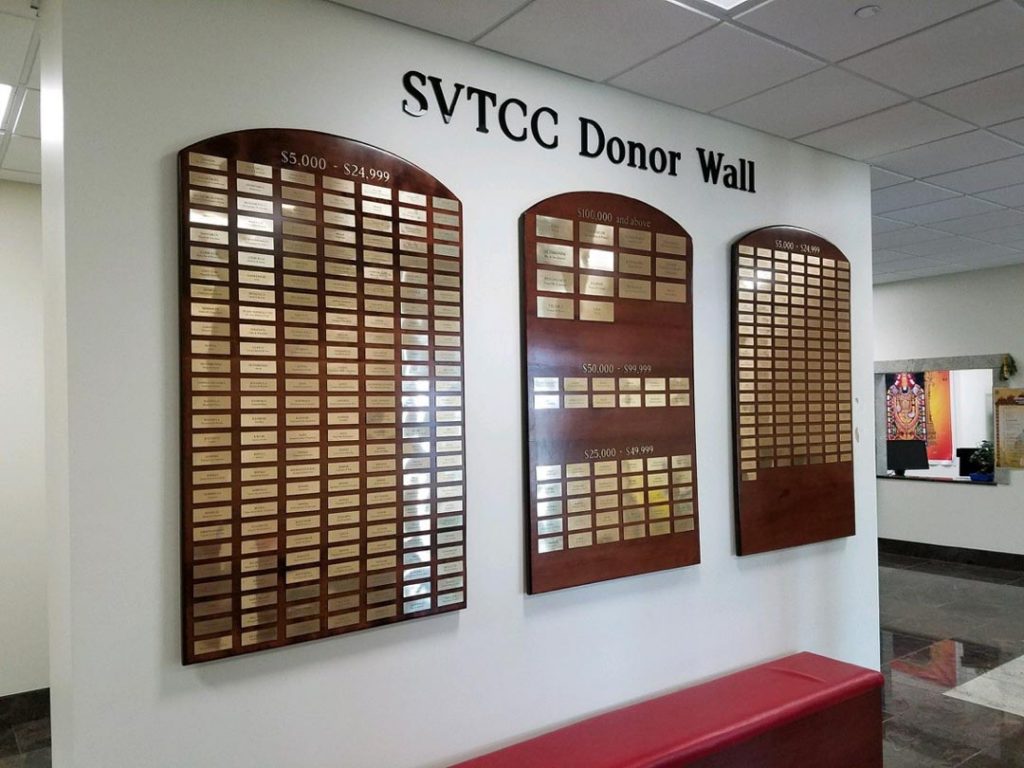Donor recognition walls are an incredibly valuable resource for nonprofit organizations. They can become a core part of your fundraising process and the way you build relationships with your supporters.
But setting up one of these displays from scratch can be overwhelming. There are many moving parts in a project like this.
In this article, we cover everything you need to know about setting up a donor recognition wall. Following our guide closely can help you get all of the benefits with less of the stress.
What are donor recognition walls?
Donor recognition walls are a kind of wall-mounted display that is normally used by nonprofit organizations to honor their donors and those who have helped them to achieve their goals. In a way, this is a celebration of their achievements as well as a show of appreciation.
As such, these boards are especially beneficial for organizations like the following:
- Schools
- Hospitals
- Universities
- Libraries
- Museums
- Shelters
- Worship facilities
- Monuments
- Or any other similar organization that might accept donations
The display will essentially be a list of the names of businesses or individuals who have contributed to raising funds. Some organizations also use them to acknowledge people who might have helped in other significant ways, like giving their time and labor.
These boards are the perfect way to thank your donors and recognize their contributions. You can use it to show them that their donation matters and that you will remember it.
In some cases, it can also be an extra incentive for local businesses or individuals to get involved. It can be an effective way to get the word out about themselves and to improve their reputation while doing some good for their community.
It’s a win for everyone involved.
Nowadays, there are countless options to customize the display. The standard donor recognition wall consists of a header with plaques below it, which are all made of engraved brass that you mount on a wood panel.
All in all, this is still an elegant and professional solution. However, as we will discuss, there are many other variations to consider.
In the next section, we will break down how these boards function and how you should approach them.
How do do donor recognition walls work?
The value of recognizing and showing appreciation to your supporters is immeasurable. That’s why it’s essential to plan ahead and make sure you get the best out of the display.
If you want to secure long-term support, it’s vital that you build a positive relationship with your donors. Research has shown that increasing donor loyalty by 10% can lead to an increase of 100 to 150% in ROI. As such, creating a donor recognition wall is a way to invest in the financial wellbeing of your organizations.
The process should start by diligently keeping track of any contributions to your organization. You then need to set up a system to decide how exactly you want to recognize the contribution. This will involve looking at the following aspects.
Choosing who to recognize
First, you need to decide who you want to recognize on the wall. Ideally, you would find a way to thank each contributor. However, it’s not always practical to show your appreciation in the same way. Instead, you can set up a threshold that determines who gets a plaque and who does not.
Most nonprofits will receive different kinds of support, for example:
- Sponsorships
- In-kind donations
- Capital campaigns
- Planned gifts
- Major donors
It’s the last two kinds of contributions that you definitely want to acknowledge in a formal way. However, it all depends on the structure of your specific venture and its general income trend.
Levels of Contribution
Now that you’ve established who you want to recognize, you can move on to the next decision. Besides this, you need to decide whether you want to distinguish between different levels of contributions.
In general, organizations find this to be useful and beneficial as donations can vary widely. One donor might give $1,000 while another gives $10,000.
To keep the design coherent and the system manageable, you can work out categories such as one for donations between $1,000- $2,000 and another for $2,000- $3,000 and so on.
How to showcase donors based on their contributions
Here are three ideas you can implement to distinguish between categories:
- Use different color plaques. For example, there could be a bronze, silver, and gold group.
- Separate the display into sections or have more than one display.
- Vary the size of the plaque according to the size of the donation.
Budget
You want to thank your donors properly for their generous contributions. But you should still take care of how much you spend. On average, organizations spend between 8 and 14% of their total annual budget on donor recognition.
This is a good rule of thumb, and it ensures that the amount you spend scales as your organization does.
Planning the unveiling of your donor recognition wall
Another important part of planning for your donor recognition wall is organizing an unveiling. It can be a valuable opportunity to thank your donors while attracting new potential donors and raising awareness.
One idea is to launch the display as the culmination of a specific campaign. It can be a great way to tie off the effort and celebrate the achievement.
Room for growth
Significantly, you should think of the donor recognition wall as a work in progress. In many ways, it’s a reflection of your venture’s journey.
In some cases, organizations might want the display to focus on one specific funding goal, such as to build a hall or something similar.
But keep in mind that if it is part of your business model to accept donations, you will likely receive more contributions in the future. It’s a good business practice to continue to recognize donors and the support they give. This will also help you encourage donations in the future.
Therefore, you need to think ahead. How can the display grow with your organization?
This will play a vital role in your planning, especially when it comes to deciding on the budget, size, layout, and location of the display.
Assigning a responsible party to manage the recognition wall
Generally, it works best to formally assign an individual or group to manage the recognition wall. Doing this will help you make sure that the display gets its due attention and that nothing slips through the cracks.
The task will mainly involve arranging for the production and installation of the sign and any future additions.
Remember that the person or persons who are assigned to this task will also need to fact-check the content. Overall, this will be one of the most critical parts of the job.
Content for the donor recognition wall
One more critical feature that you need to figure out in the planning and preparation stage is the precise contents of the display. Space can be a bit of an issue. So you will need to focus on what is essential information to convey.
Besides this, neither you or the donor might want all the details about their contribution to be revealed.
Possible details to include are:
- Date
- Amount donated
- Type of donation
- Name of individual or business
- The company’s logo
- Role in the organization
- Length of support
- A milestone which was funded
- Name of the award
However, in most cases, organizations find it sufficient to only include the name of the individual or business and the year in which the support was given.
In addition to this, you should explain the display in some way and make its purpose clear. Your explanation could appear as part of the header or underneath the header of the whole board. Or you could write a brief introduction to each individual plaque.
Donation Plaque Wording
You want to select the wording for this with care so that it feels like a reward for the donor and can encourage new potential contributors.
Some brilliant examples of possible phrases are:
- “In recognition of…”
- “Donated in honor of…”
- “Dedicated by…”
- “Made possible by…”
Where should you mount your donor recognition wall?
There is no one place to mount a donor recognition wall. However, you should place it somewhere where most visitors will be able to see it.
Consider too, that a well-designed donor recognition wall can add to the aesthetic of your offices. You can even design it to become the centerpiece of a specific room. Serving multiple purposes is an example of signage at its best.
As we’ve said, the display will probably grow over the years. So it’s a good idea to pick a spot with a lot of space.
Here are some of the most popular spots where organizations place donor recognition walls:
- Lobbies
- Reception areas
- High traffic hallways
- Back of a hall
- Waiting area
- Eating hall or cafeteria
Designing the display
All of the above needs to be taken into account when you’re ready to start designing the display. If you do this, you will end up with the perfect way for your organization to demonstrate the respect and esteem you have for your supporters.
Let’s look at the key features of the design with some examples.
Layout of the donor recognition wall
All in all, the layout of donor recognition walls can be much trickier to figure out than with other types of signage. But on the bright side, it also means that there are more opportunities for creativity and thinking outside the box.
If above all, you are looking for a neat and professional-looking display, it can be a good idea to go for a standard layout. In this case, you would use plaques that are arranged in tidy rows or columns. You can place them next to or underneath each other.
However, that certainly isn’t your only option. Alternatively, you can choose to arrange the names in a way that would be thematically relevant.
For example, if your organization raises funds for environmental awareness or something similar, you could design the display to look like a tree. Then each plaque can be a leaf on the branches of the tree.
Another idea is to print the different names on different colored plaques and then arrange them in a mosaic type layout.
Styles for the donor recognition wall
The style is the overall look of the donor recognition wall. What are you trying to achieve with the display? Are you going for a sleek and sophisticated look or something more contemporary?
Once you’ve decided this, it can help guide you through crafting each element of the sign.
For example, take a look at the wall of fame we at Signarama made for Lamphere High School. The board resembles more traditional styles in terms of its layout. But they wanted to mix things up a bit to get a more exciting and modern aesthetic.
So instead of using the standard brass, they opted for routed brushed aluminum in silver and blue to create a style of their own.
Branding for the donor recognition wall
There is more than one way that you can put a unique stamp on a donor recognition wall. It all comes down to customizing the details. Besides the layout and style, you can make your display stand out by incorporating elements of your branding.
The display for Warren’s public library is a brilliant example of this. From the text to the use of logos and graphics, they made sure that the board is recognizable. On top of making the display attractive and appealing, it also leaves no doubt about whom the sign belongs to.
Say thank you in style
Thanking your donors isn’t only a nice or ethical thing to do. Instead, it’s also an important business practice that can lead to tangible benefits for your organization. Donor recognition walls are an ideal long-term solution for this.
It can form the central aspect of the way you approach your sponsors, which you can combine effectively with additional measures like event sponsor signage. Overall, signs can be a brilliant way to advertise fundraisers for your school or nonprofit event.




